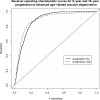Prospective assessment of genetic effects on progression to different stages of age-related macular degeneration using multistate Markov models
- PMID: 22247473
- PMCID: PMC3339916
- DOI: 10.1167/iovs.11-8657
Prospective assessment of genetic effects on progression to different stages of age-related macular degeneration using multistate Markov models
Abstract
Purpose: Understanding the effect of genes on progression to different stages of age-related macular degeneration (AMD) may suggest stage-specific therapeutic targets and more precise prediction of the development of this disease.
Methods: Progression events and time to each stage of AMD were derived from the longitudinal data of 2560 subjects without advanced AMD. SNPs in 12 AMD risk loci were genotyped. A multistate Markov model for progression from normal to intermediate drusen, then to large drusen, and eventually to neovascular disease (NV) or geographic atrophy (GA) was applied to estimate stage-specific hazard ratios for each SNP. The effects of these genetic factors were also estimated by a multivariate multistate Markov model adjusted for baseline age, sex, smoking, body mass index (BMI), education, antioxidant treatment, and the status of AMD in the fellow eye.
Results: Controlling for demographic and behavioral factors and other SNPs, the TT genotype of rs10468017 in LIPC was associated with decreased risk of progression from large drusen to NV (HR = 0.57, P = 0.04) and tended to reduce the risk of progression from normal to intermediate drusen (HR = 0.72, P = 0.07). The SNP rs1883025 (T allele) in ABCA1 was associated with decreased risk of progression from normal to intermediate drusen (HR per allele = 0.82 per allele, P = 9.7 × 10(-3)) and from intermediate drusen to large drusen (HR per allele = 0.77, P = 5.2 × 10(-3)). The genes CFH, C3, CFB, and ARMS2/HTRA1 were associated with progression from intermediate drusen to large drusen and from large drusen to GA or NV.
Conclusions: Genes in different pathways influence progression to different stages of AMD.
Figures




References
-
- Abdelsalam A, Del Priore L, Zarbin MA. Drusen in age-related macular degeneration: pathogenesis, natural course, and laser photocoagulation-induced regression. Surv Ophthalmol. 1999;44:1–29 - PubMed
-
- Seddon JM, Sobrin L. Epidemiology of age-related macular degeneration. In: Albert D, Miller J, Azar D, Blodi B, eds. Albert & Jakobiec's Principles and Practice of Ophthalmology. Philadelphia: W.B. Saunders; 2007:413–422
Publication types
MeSH terms
Substances
Grants and funding
LinkOut - more resources
Full Text Sources
Other Literature Sources
Medical
Molecular Biology Databases
Miscellaneous

